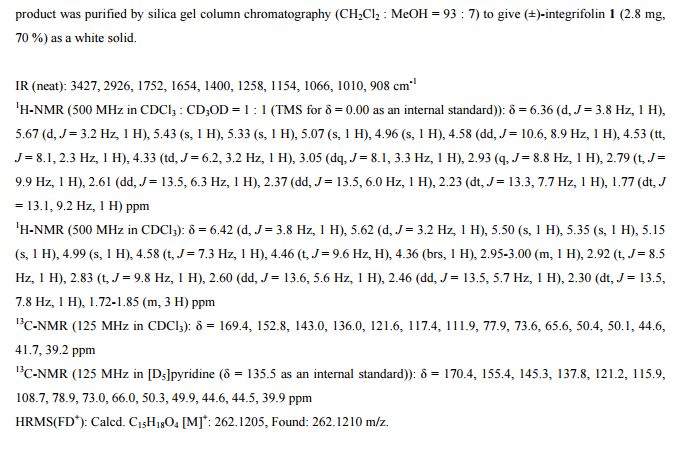CAS 89647-87-0
C15 H18 O4, 262.30
Azuleno[4,5-b]furan-2(3H)-one, decahydro-4,8-dihydroxy-3,6,9-tris(methylene)-, (3aR,4R,6aR,8S,9aR,9bR)-
- Azuleno[4,5-b]furan-2(3H)-one, decahydro-4,8-dihydroxy-3,6,9-tris(methylene)-, [3aR-(3aα,4β,6aα,8β,9aα,9bβ)]-
- (3aR,4R,6aR,8S,9aR,9bR)-Decahydro-4,8-dihydroxy-3,6,9-tris(methylene)azuleno[4,5-b]furan-2(3H)-one
- 8-epi-Deacylcynaropicrin
- 8β-Hydroxyzaluzanin C
- Integrifolin
- Integrifolin (guaianolide)
Paper

(±)-Integrifolin
Wiley-VCH Verlag GmbH & Co. KGaA, Weinheim
Total Synthesis of (±)-Integrifolin
Compound from plants keeps human cancer cells from multipying
Read more at Wiley-VCH Verlag GmbH & Co. KGaA, Weinheim
(±)-Integrifolin

Banksia integrifolia
Coast Banksia
Family: Proteaceae
Banksia integrifolia is a tall shrub or small tree 6 - 16m tall. It is common in sandy coastal areas, but also grows in the forests of tablelands. The light grey bark is hard and rough.
Mature leaves 5 -10 cm long, are stiff, entire (untoothed), dull dark green above and hairy-white underneath. They are generally lanceolate. Younger leaves are irregularly toothed and shorter than the mature leaves. The species name 'integrifolia' means whole-leaved.
The pale yellow flower spikes of Banksia integrifolia range from 7-14cm long and 7cm wide. The bent styles emerge from individual flowers on the spike, straightening and spreading.
A short time after flowering, the seed pods protrude cleanly from the woody cone and open to shed black, papery, winged seeds.
Banksia integrifolia flowers from January to June.
///////(±)-Integrifolin, human cancer cells, multipying
C=C1C(=O)O[C@@H]2[C@H]3C(=C)[C@@H](O)C[C@H]3C(=C)C[C@@H](O)[C@@H]12


